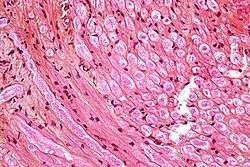Nerve fiber
| Nerve fiber | |
|---|---|
 Micrograph showing nerve fibers in a nerve root. HPS stain. | |
| Details | |
| Identifiers | |
| Latin | neurofibra |
| MeSH | Nerve+Fibers |
| Code | TA A14.0.00.001 |
A nerve fiber is a threadlike extension of a nerve cell and consists of an axon and (in some cases) a myelin sheath. There are nerve fibers in the central nervous system and peripheral nervous system. In the central nervous system (CNS), myelin is produced by oligodendroglia cells. Schwann cells form myelin in the peripheral nervous system (PNS). Schwann cells can also make a thin covering for an axon which does not consist of myelin (in the PNS). A peripheral nerve fiber consists of an axon, myelin sheath, Schwann cells and its endoneurium. There are no endoneurium and Schwann cells in the central nervous system.
Central nerve fibers
In the central nervous system, nerve fibers differ in terms of size, conduction velocity, and presence or lack of myelin. For example, the olfactory nerve fibers are short and without myelin, but the optic nerve fibers are myelinated (the olfactory and optic nerves are considered as a parts of the CNS, while other cranial nerves are a component of the PNS). A bundle of nerve fibers constitutes a tract in the central nervous system. The pyramidal tract and extrapyramidal tracts have long nerve fibers that descend from the brain to the spinal cord. These fibers have an important role in motor control, and are known as descending tracts. There are other bundles of nerve fibers in the CNS that are called ascending tracts.These carry sensory information from the periphery to the different areas of the brain (such as the cerebral cortex, cerebellum, and brain stem).
Descending nerve fibers (Upper motor neurons)
- Pyramidal system
- Corticospinal tract (or Pyramidal tract)
- Corticobulbar tract
- Extrapyramidal tracts
- Descending autonomic fibers
- Hypothalamobulbar fibers
- Hypothalamospinal fibers
Ascending nerve fibers
- Spinothalamic tract
- Fasciculus cuneatus
- Fasciculus gracilis
- Spinoreticular tract
- Spinotectal tract
- Spinocerebellar tract
- Spinocervical tract
Peripheral nerve fiber types
A nerve may be sensory, motor or sensory-motor (mixed). There are three types of nerve fibers in a mixed nerve that include:
- Sensory nerve fibers (afferent fibers)
- Motor nerve fibers (efferent fibers)
- Autonomic nerve fibers (autonomic fibers)
Components of peripheral nerve fiber
Each peripheral nerve fiber contains:
- An axon (or a long dendrite of sensory fiber that also is known as an axon)
- Axolemma
- Myelin sheath (not always)
- Schwann's sheath (neurolemma)
- Endoneurium
Classification of peripheral nerve fibers
There are three types of peripheral nerve fibers based on their diameter:
- A group
- B group
- C group
Class A
Fibers of the A group have a large diameter, are myelinated, and have the highest conduction velocity of all the nerves in the body.
The A group consists of four types of nerve fibers:
- A alpha fibers (afferent or efferent fibers)
- A beta fibers (afferent or efferent fibers)
- A gamma fibers (efferent fibers)
- A delta fibers (afferent fibers)
Class B
Nerve fibers in this group are myelinated with a small diameter. Generally, they are the preganglionic fibers of the autonomic nervous system and have a low conduction velocity.
Motor fibers of the A group
A alpha fibers
- Characteristics:
- High conduction velocity
- By alpha motor neuron for muscle contraction.
- Alpha motor neurons innervate extrafusal muscle fibers (slow and fast fibers)
A beta fibers
- Characteristics:
- By beta motor neuron for muscle spindle fibers contraction.
- Beta motor neurons innervate intrafusal muscle fibers of muscle spindles (nuclear bag and nuclear chain fibers), with collaterals to extrafusal muscle fibers.
A gamma fibers
- Characteristics:
- By gamma motor neuron for muscle spindle fibers contraction.
- Gamma motor neurons innervate intrafusal muscle fibers of muscle spindles (nuclear bag and nuclear chain fibers).
Sensory fibers of the A group
A alpha fibers (Ia fiber or Ib fibers)
- Characteristics:
- High conduction velocity
- Ia fibers are related to muscle spindle primary endings (muscle sense)
- Ib fibers are related to golgi tendon organs (muscle sense)
A beta fibers (II fibers)
- II fibers carry sensory information related to muscle spindle secondary endings, touch, and kinesthesia.
A delta fibers (III fibers)
- III fibers carry sensory information related to pain and cold temperature.
Regeneration of peripheral nerve fibers
Nerves can be easily damaged in a traumatic event due to their sometimes vulnerable positions in the body. However, if a nerve is damaged, it does have the ability to regenerate if its soma and a small portion of the neurilemma remain. The nerve begins the process by destroying the nerve distal to the site of injury allowing Schwann cells, basal lamina, and the neurilemma near the injury to begin producing a regeneration tube. Nerve growth factors are produced causing many nerve sprouts to bud. When one of the growth processes finds the regeneration tube, it begins to grow rapidly towards its original destination guided the entire time by the regeneration tube. Nerve regeneration is very slow and can take up to several months to complete. While this process does repair some nerves, there will still be some functional deficit as the repairs are not perfect.[1]
See also
References
- ↑ Burnett & Zager, Mark & Eric. "Pathophysiology of Peripheral Nerve Injury: A Brief Review: Nerve Regeneration". Medscape Article. Medscape. Retrieved 2011-10-26.
Further reading
- Peter L. Williams et. al, ed. (1989). Gray's anatomy (37th ed.). Edinburgh: Churchill Livingstone. ISBN 0-443-04177-6.
- Guyton, Arthur C. (1986). Textbook of medical physiology (7th ed.). Philadelphia: Saunders. ISBN 0-7216-1260-1.
- http://www.unmc.edu/physiology/Mann/mann12.html
- http://www.boddunan.com/education/20-medicine-a-surgery/12730-nerve-fiber-types-and-function.html
- "Pathophysiology of Peripheral Nerve Injury: A Brief Review: Nerve Regeneration." 2004.
- http://www.medscape.com/viewarticle/480071_5 (accessed 5 December 2010).
- Saladin, Kenneth S. Anatomy and Physiology The Unity of Form and Function. Fifth ed. New York: McGraw Hill, 2010.